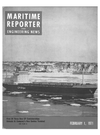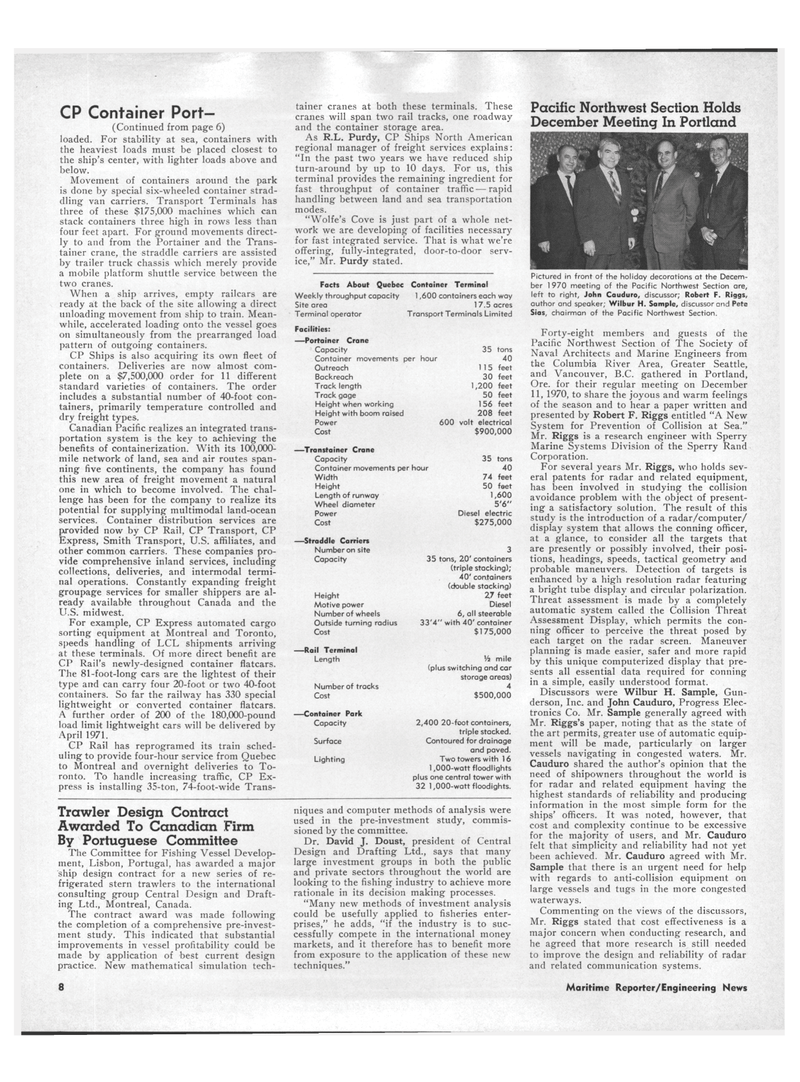
Page 6: of Maritime Reporter Magazine (February 1971)
Read this page in Pdf, Flash or Html5 edition of February 1971 Maritime Reporter Magazine
CP Container Port— (Continued from page 6) loaded. For stability at sea, containers with the heaviest loads must be placed closest to the ship's center, with lighter loads above and below.
Movement of containers around the park is done by special six-wheeled container strad- dling van carriers. Transport Terminals has three of these $175,000 machines which can stack containers three high in rows less than four feet apart. For ground movements direct- ly to and from the Portainer and the Trans- tainer crane, the straddle carriers are assisted by trailer truck chassis which merely provide a mobile platform shuttle service between the two cranes.
When a ship arrives, empty railcars are ready at the back of the site allowing a direct unloading movement from ship to train. Mean- while, accelerated loading onto the vessel goes on simultaneously from the prearranged load pattern of outgoing containers.
CP Ships is also acquiring its own fleet of containers. Deliveries are now almost com- plete on a $7,500,000 order for 11 different standard varieties of containers. The order includes a substantial number of 40-foot con- tainers, primarily temperature controlled and dry freight types.
Canadian Pacific realizes an integrated trans- portation system is the key to achieving the benefits of containerization. With its 100,000- mile network of land, sea and air routes span- ning five continents, the company has found this new area of freight movement a natural one in which to become involved. The chal- lenge has been for the company to realize its potential for supplying multimodal land-ocean services. Container distribution services are provided now by CP Rail, CP Transport, CP
Express, Smith Transport, U.S. affiliates, and other common carriers. These companies pro- vide comprehensive inland services, including collections, deliveries, and intermodal termi- nal operations. Constantly expanding freight groupage services for smaller shippers are al- ready available throughout Canada and the
U.S. midwest.
For example, CP Express automated cargo sorting equipment at Montreal and Toronto, speeds handling of LCL shipments arriving at these terminals. Of more direct benefit are
CP Rail's newly-designed container flatcars.
The 81-foot-long cars are the lightest of their type and can carry four 20-foot or two 40-foot containers. So far the railway has 330 special lightweight or converted container flatcars.
A further order of 200 of the 180,000-pound load limit lightweight cars will be delivered by
April 1971.
CP Rail has reprogramed its train sched- uling to provide four-hour service from Quebec to Montreal and overnight deliveries to To- ronto. To handle increasing traffic, CP Ex- press is installing 35-ton, 74-foot-wide Trans- tainer cranes at both these terminals. These cranes will span two rail tracks, one roadway and the container storage area.
As R.L. Purdy, CP Ships North American regional manager of freight services explains: "In the past two years we have reduced ship turn-around by up to 10 days. For us, this terminal provides the remaining ingredient for fast throughput of container traffic—rapid handling between land and sea transportation modes. "Wolfe's Cove is just part of a whole net- work we are developing of facilities necessary for fast integrated service. That is what we're offering, fully-integrated, door-to-door serv- ice," Mr. Purdy stated.
Facts About Quebec Container Terminal
Weekly throughput capacity 1,600 containers each way
Site area 17.5 acres
Terminal operator Transport Terminals Limited
Facilities: —Portoiner Crane
Capacity
Container movements per hour
Outreach
Backreach
Track length
Track gage
Height when working
Height with boom raised
Power
Cost —Transtainer Crane
Capacity
Container movements per hour
Width
Height
Length of runway
Wheel diameter
Power
Cost 35 tons 40 1 1 5 feet 30 feet 1,200 feet 50 feet 156 feet 208 feet 600 volt electrical $900,000 35 tons 40 74 feet 50 feet 1,600 5'6"
Diesel electric $275,000 -Straddle Carriers
Number on site
Capacity
Height
Motive power
Number of wheels
Outside turning radius
Cost —Rail Terminal
Length
Number of tracks
Cost —Container Park
Capacity
Surface
Lighting 35 tons, 20' containers (triple stacking); 40' containers (cfouble stacking) 27 feet
Diesel 6, all steerable 33'4" with 40' container $175,000
V& mile (plus switching and car storage areas) 4 $500,000 2,400 20-foot containers, triple stacked.
Contoured for drainage and paved.
Two towers with 16 1,000-watt floodlights plus one central tower with 32 1,000-watt floodights.
Trawler Design Contract
Awarded To Canadian Firm
By Portuguese Committee
The Committee for Fishing Vessel Develop- ment, Lisbon, Portugal, has awarded a major ship design contract for a new series of re- frigerated stern trawlers to the international consulting group Central Design and Draft- ing Ltd., Montreal, Canada.
The contract award was made following the completion of a comprehensive pre-invest- ment study. This indicated that substantial improvements in vessel profitability could be made by application of best current design practice. New mathematical simulation tech- 8 niques and computer methods of analysis were used in the pre-investment study, commis- sioned by the committee.
Dr. David J. Doust, president of Central
Design and Drafting Ltd., says that many large investment groups in both the public and private sectors throughout the world are looking to the fishing industry to achieve more rationale in its decision making processes. "Many new methods of investment analysis could be usefully applied to fisheries enter- prises," he adds, "if the industry is to suc- cessfully compete in the international money markets, and it therefore has to benefit more from exposure to the application of these new techniques."
Pacific Northwest Section Holds
December Meeting In Portland
Pictured in front of the holiday decorations at the Decem- ber 1970 meeting of the Pacific Northwest Section are, left to right, John Cauduro, discussor; Robert F. Riggs, author and speaker; Wilbur H. Sample, discussor and Pete
Sias, chairman of the Pacific Northwest Section.
Forty-eight members and guests of the
Pacific Northwest Section of The Society of
Naval Architects and Marine Engineers from the Columbia River Area, Greater Seattle, and Vancouver, B.C. gathered in Portland,
Ore. for their regular meeting on December 11, 1970, to share the joyous and warm feelings of the season and to hear a paper written and presented by Robert F. Riggs entitled "A New
System for Prevention of Collision at Sea."
Mr. Riggs is a research engineer with Sperry
Marine Systems Division of the Sperry Rand
Corporation.
For several years Mr. Riggs, who holds sev- eral patents for radar and related equipment, has been involved in studying the collision avoidance problem with the object of present- ing a satisfactory solution. The result of this study is the introduction of a radar/computer/ display system that allows the conning officer, at a glance, to consider all the targets that are presently or possibly involved, their posi- tions, headings, speeds, tactical geometry and probable maneuvers. Detection of targets is enhanced by a high resolution radar featuring a bright tube display and circular polarization.
Threat assessment is made by a completely automatic system called the Collision Threat
Assessment Display, which permits the con- ning officer to perceive the threat posed by each target on the radar screen. Maneuver planning is made easier, safer and more rapid by this unique computerized display that pre- sents all essential data required for conning in a simple, easily understood format.
Discussors were Wilbur H. Sample, Gun- derson, Inc. and John Cauduro, Progress Elec- tronics Co. Mr. Sample generally agreed with
Mr. Riggs's paper, noting that as the state of the art permits, greater use of automatic equip- ment will be made, particularly on larger vessels navigating in congested waters. Mr.
Cauduro shared the author's opinion that the need of shipowners throughout the world is for radar and related equipment having the highest standards of reliability and producing information in the most simple form for the ships' officers. It was noted, however, that cost and complexity continue to be excessive for the majority of users, and Mr. Cauduro felt that simplicity and reliability had not yet been achieved. Mr. Cauduro agreed with Mr.
Sample that there is an urgent need for help with regards to anti-collision equipment on large vessels and tugs in the more congested waterways.
Commenting on the views of the discussors,
Mr. Riggs stated that cost effectiveness is a major concern when conducting research, and he agreed that more research is still needed to improve the design and reliability of radar and related communication systems.
Maritime Reporter/Engineering News

 5
5

 7
7
